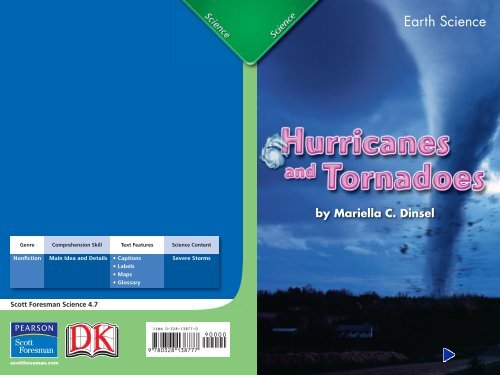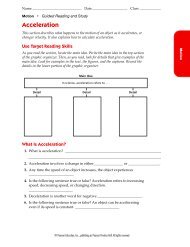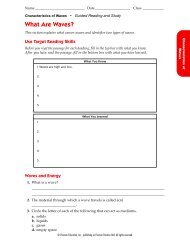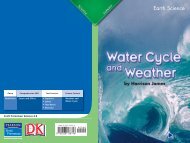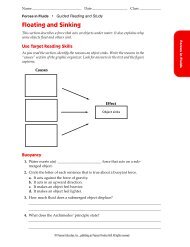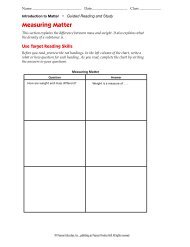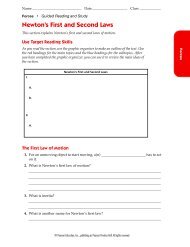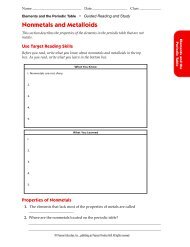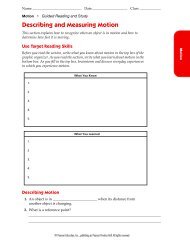Hurricanes and Tornadoes - district87.org
Hurricanes and Tornadoes - district87.org
Hurricanes and Tornadoes - district87.org
Create successful ePaper yourself
Turn your PDF publications into a flip-book with our unique Google optimized e-Paper software.
Earth Science<br />
by Mariella C. Dinsel<br />
Genre Comprehension Skill Text Features Science Content<br />
Nonfiction Main Idea <strong>and</strong> Details • Captions<br />
• Labels<br />
• Maps<br />
• Glossary<br />
Severe Storms<br />
Scott Foresman Science 4.7<br />
ì
Vocabulary<br />
hurricane<br />
storm surge<br />
tornado<br />
tropical depression<br />
tropical storm<br />
vortex<br />
<strong>Hurricanes</strong> <strong>and</strong> <strong>Tornadoes</strong><br />
What did you learn<br />
1. How is the eye of a hurricane different from the rest of<br />
the storm by Mariella C. Dinsel<br />
2. What is a storm surge Why is it dangerous<br />
3. Why are tornadoes difficult to forecast<br />
4. A tropical storm goes through<br />
many stages before it forms a hurricane. Explain on your<br />
own paper what these stages are. Include details from<br />
the book to support your answer.<br />
5. Main Idea <strong>and</strong> Details Reread the “How<br />
<strong>Tornadoes</strong> Form” section on page 12. What is the main<br />
idea of this section What are some supporting details<br />
Illustration: 12 Tony R<strong>and</strong>azzo<br />
Photographs: Every effort has been made to secure permission <strong>and</strong> provide appropriate credit for<br />
photographic material. The publisher deeply regrets any omission <strong>and</strong> pledges to correct errors called to its<br />
attention in subsequent editions. Unless otherwise acknowledged, all photographs are the property of Scott<br />
Foresman, a division of Pearson Education. Photo locators denoted as follows: Top (T), Center (C), Bottom<br />
(B), Left (L), Right (R) Background (Bkgd)<br />
Opener: Getty Images Title Page: ©Japan Meteorological Agency 2 ©Reuters/Corbis 4 (L, C) ©Japan<br />
Meteorological Agency 5 (CR, R) ©Japan Meteorological Agency 6 ©Japan Meteorological Agency 7<br />
©Adastra/Getty Images 8 ©DK Images 9 (CR) ©Morton Beebe/Corbis, (BR) ©Cameron Davidson 10<br />
NASA 13 (CL) ©ANT Photo Library/NHPA Limited, (CR) ©H. Hoflinger/FLPA-Images of Nature 14 ©Jim<br />
Reed/Photo Researchers, Inc. 15 ©Reuters/Corbis<br />
ISBN: 0-328-13877-0<br />
Copyright © Pearson Education, Inc.<br />
All Rights Reserved. Printed in the United States of America. This publication is<br />
protected by Copyright <strong>and</strong> permission should be obtained from the publisher prior<br />
to any prohibited reproduction, storage in a retrieval system, or transmission in any<br />
form by any means, electronic, mechanical, photocopying, recording, or likewise. For<br />
information regarding permissions, write to: Permissions Department, Scott Foresman,<br />
1900 East Lake Avenue, Glenview, Illinois 60025.<br />
3 4 5 6 7 8 9 10 V010 13 12 11 10 09 08 07 06 05
What are hurricanes<br />
How Tropical Storms Become <strong>Hurricanes</strong><br />
A low pressure area formed over part of the Atlantic Ocean<br />
in August 1992. It became stronger <strong>and</strong> bigger. It grew into a<br />
powerful tropical storm named Andrew. It became even more<br />
powerful. It became Hurricane Andrew.<br />
The area near the equator is known as the tropics. Tropical<br />
storms form there. A hurricane is a dangerous storm formed<br />
by b<strong>and</strong>s of thunderstorms wrapping around its center. It has<br />
wind speeds of at least 119 kilometers per hour.<br />
Hurricane Andrew moved west across the Atlantic. It first hit<br />
the Bahama Isl<strong>and</strong>s. It moved toward Florida. The winds near<br />
the center of the storm may have been as fast as 250 kilometers<br />
per hour. You would run an entire mile in less than 25 seconds<br />
if you moved that fast!<br />
Hurricane Andrew crossed southern Florida in about four<br />
hours. Over l<strong>and</strong>, the storm became weaker. But it became<br />
strong again when it reached the warm waters of the Gulf<br />
of Mexico. From there, it moved on to Louisiana. Then it<br />
continued north. The storm again weakened. But its rain<br />
caused a great deal of flooding.<br />
This hurricane was one of the most expensive natural<br />
disasters in the history of the United States. It caused many<br />
deaths. It damaged <strong>and</strong> destroyed many businesses <strong>and</strong> houses.<br />
2<br />
3
Stages of Tropical Storms<br />
A tropical storm must have certain things to form. It needs<br />
warm ocean water. It also needs an area of low air pressure<br />
at the ocean’s surface. Winds blow toward this area of low<br />
pressure. The warm ocean water provides heat <strong>and</strong> water vapor.<br />
The warm, moist air rises. Water vapor condenses <strong>and</strong> forms<br />
clouds. A tropical disturbance develops.<br />
The clouds in a tropical disturbance can become<br />
thunderstorms. Water vapor condenses, releasing heat energy.<br />
The thunderstorms grow as the air inside them becomes<br />
warmer. Winds increase <strong>and</strong> begin to swirl. The storms become<br />
a tropical depression. A tropical depression can have winds<br />
moving as fast as 61 kilometers per hour. These winds can<br />
increase <strong>and</strong> form a tropical storm. The winds in a tropical<br />
storm blow faster than 62 kilometers per hour. The air pressure<br />
in the storm drops.<br />
How <strong>Hurricanes</strong> Form<br />
Thunderstorms grow out of<br />
a tropical depression.<br />
Air pressure at the<br />
ocean’s surface<br />
drops. Surface<br />
winds blow faster<br />
<strong>and</strong> begin to swirl.<br />
A tropical storm<br />
develops.<br />
Thunderstorms begin to<br />
move in spiral b<strong>and</strong>s. Air<br />
pressure drops lower, <strong>and</strong><br />
surface winds blow faster.<br />
The tropical storm is now<br />
a hurricane.<br />
4<br />
5
Hurricane as a System<br />
Thunderstorms move toward the area with the lowest air<br />
pressure. They move in a spinning pattern. A lot of air moves<br />
out of the top of the storm. Less air moves in at the surface of<br />
the ocean. Air pressure keeps dropping. This makes the winds<br />
blow even faster. When the wind speeds reach 119 kilometers<br />
per hour, the storm is a hurricane.<br />
Parts that work together or affect each other make up a<br />
system. The atmosphere <strong>and</strong> the ocean are two of Earth’s<br />
systems. Together they produce a hurricane. <strong>Hurricanes</strong> are<br />
systems. They form in the atmosphere. They get energy from<br />
the ocean.<br />
<strong>Hurricanes</strong> can change Earth’s systems. They can change the<br />
l<strong>and</strong>. They can cause huge waves. They can change the shape<br />
of a coastline.<br />
The Hurricane’s Eye<br />
The eye of a hurricane is the calm area in the middle of the<br />
storm. The hurricane spins around its eye. The winds in the<br />
eye are gentle. The eye has little or no rain. The thunderstorms<br />
around the eye have the strongest winds <strong>and</strong> heaviest rains. A<br />
typical hurricane’s eye is about 20 to 50 kilometers across.<br />
People under the eye may think the hurricane has passed.<br />
They must be careful. They need to be in a safe place when the<br />
other half of the hurricane sweeps in.<br />
6<br />
7
The Effects of Winds <strong>and</strong> Water<br />
A hurricane can destroy many things on l<strong>and</strong>. Its winds can<br />
knock down trees. They can completely flatten buildings. The<br />
winds can pick up objects <strong>and</strong> throw them. <strong>Hurricanes</strong> are put<br />
in categories based on their wind speed.<br />
The water from a hurricane often does the most damage.<br />
Rain can mix with soil. This can lead to mudslides. Even<br />
though a hurricane loses strength as it moves over l<strong>and</strong>, it can<br />
cause deadly floods.<br />
The winds of a hurricane can force large ocean waves onto<br />
the shore. A storm surge is the rise in sea level caused by<br />
a storm’s winds. A storm surge can make flooding worse. It<br />
can sweep large boats onto l<strong>and</strong>. In 1900, a hurricane over<br />
Galveston, Texas caused a storm surge that killed more than<br />
6,000 people.<br />
But a hurricane can be helpful in some ways. The rain<br />
reduces the chances of wildfires. The storm can kill non-native<br />
plants. This makes room for native plants to grow.<br />
Thunderstorms<br />
move in spiral<br />
b<strong>and</strong>s around<br />
the eye.<br />
High above the surface, winds blow out<br />
<strong>and</strong> away from the hurricane.<br />
When the hurricane<br />
moves over l<strong>and</strong>, its<br />
thunderstorms can<br />
produce violent winds<br />
called tornadoes.<br />
Fast-moving<br />
ocean currents<br />
carry s<strong>and</strong> away<br />
from dunes <strong>and</strong><br />
beaches.<br />
Strong winds push<br />
ocean water in front<br />
of the hurricane onto<br />
l<strong>and</strong> in a storm surge.<br />
High waves move<br />
farther onto l<strong>and</strong><br />
on top of the<br />
storm surge.<br />
8<br />
9
How Scientists Predict <strong>Hurricanes</strong><br />
It used to be hard to tell when a hurricane was coming. Now<br />
scientists make weather forecasts. The weather forecasts tell<br />
people about hurricanes that are far away.<br />
Scientists get information from instruments all over the<br />
world. There are satellites high above Earth’s surface. They can<br />
tell about a hurricane’s rainfall. Pilots fly special planes into<br />
hurricanes to get information. This information helps scientists<br />
make computer models. A model shows a system or set of<br />
events. Models help people study things that are too big or too<br />
dangerous to study directly.<br />
Computer models can predict the<br />
strength, direction, <strong>and</strong> speed<br />
of a hurricane. Scientists<br />
compare the forecasts<br />
made by the models to<br />
what really happens.<br />
Then they fix the<br />
models to make them<br />
more accurate.<br />
Hurricane Models<br />
Hurricane models predict what path the storm will take. A<br />
forecast shows where a hurricane is <strong>and</strong> where it might go. The<br />
map below is a forecast for Hurricane Frances. Scientists try<br />
to predict what path a storm will take, <strong>and</strong> what areas it will<br />
affect. As they predict further into the future, they exp<strong>and</strong> the<br />
area that might be affected.<br />
Teamwork of Scientists<br />
Scientists work together to make predictions about<br />
hurricanes. Some may study how heat moves. Others<br />
may study how the winds in the atmosphere will affect a<br />
hurricane. Scientists share their information to make the best<br />
possible forecast.<br />
<br />
<br />
<br />
<br />
<br />
<br />
<br />
<br />
<br />
<br />
<br />
<br />
<br />
<br />
<br />
<br />
Satellites can collect<br />
wind speed <strong>and</strong> water<br />
temperature data.<br />
M E X IC O<br />
<br />
<br />
<br />
CUBA<br />
HAITIDOM. REP.<br />
10<br />
11
Before thunderstorms<br />
form, winds change<br />
direction <strong>and</strong> increase<br />
in speed. Winds begin<br />
to spin.<br />
As the thunderstorm<br />
forms, air within it rises.<br />
The spinning air begins<br />
to tilt upward.<br />
What are<br />
tornadoes<br />
How <strong>Tornadoes</strong> Form<br />
A funnel cloud is a spinning<br />
column of air. It comes out of<br />
a thunderstorm. It becomes a<br />
tornado when it touches the<br />
ground. The air pressure is low in<br />
the center of a tornado. The wind<br />
speeds of most tornadoes are less<br />
than 200 kilometers per hour. But<br />
the winds can reach 500 kilometers<br />
per hour. These are the fastest<br />
winds on Earth.<br />
A tornado begins as a spinning<br />
column of air. The column may<br />
become shaped like a funnel. The<br />
funnel becomes longer <strong>and</strong> thinner.<br />
It gains speed. As it moves, it may<br />
pick up anything in its path. The<br />
funnel cloud reaches down toward<br />
the ground. It is a tornado when it<br />
actually touches the ground.<br />
The Vortex<br />
A vortex is an area where air or liquid spins in circles. You<br />
may see a vortex when water drains from a sink. A tornado is<br />
a vortex that forms within a thunderstorm. Air rushes up along<br />
the outside of a tornado.<br />
Air moves down through the center of a tornado, where the<br />
air pressure is low. Water vapor condenses in the rising air.<br />
A funnel cloud may form below the storm. The vortex may<br />
become more visible as the funnel cloud picks up dust. But a<br />
tornado can be hidden by heavy rain, dust, or nighttime.<br />
Dust Devil<br />
A dust devil is a column of<br />
spinning air. It is not a tornado.<br />
Its winds are much slower. Dust<br />
devils are often found in places<br />
such as deserts, where columns of<br />
hot air rise.<br />
Waterspout<br />
A waterspout is a rapidly spinning<br />
column of air over a lake or ocean.<br />
It lifts water drops. A waterspout is<br />
connected to a cloud. It may be a<br />
tornado that started over l<strong>and</strong> <strong>and</strong><br />
then moved over water.<br />
The area of spinning<br />
grows wider.<br />
12<br />
13
Forecasting <strong>Tornadoes</strong><br />
Only some strong thunderstorms produce tornadoes. It is<br />
hard to forecast tornadoes. They form <strong>and</strong> move quickly.<br />
A tornado can destroy weather equipment. It<br />
can destroy everything in its path. Scientists<br />
can look inside thunderstorms. They use<br />
Doppler radar to do this. Doppler radar<br />
finds information, such as the direction<br />
<strong>and</strong> speed of wind.<br />
Classifying <strong>Tornadoes</strong><br />
The damage caused by tornadoes<br />
can help scientists learn how strong<br />
the storm’s winds were. Scientists group<br />
tornadoes by damage <strong>and</strong> wind speed. They<br />
use a scale developed by scientist T. Theodore Fujita.<br />
Safety<br />
The National Weather Service tells people about tornadoes.<br />
A tornado watch means a tornado is likely to form. A tornado<br />
warning means a tornado has been observed.<br />
During a tornado, go to a basement or a small space, such as<br />
a bathroom or closet. Do not go near outside walls or windows.<br />
You are not safe in a car. <strong>Tornadoes</strong> can pick up cars <strong>and</strong> then<br />
drop them.<br />
Comparing <strong>Tornadoes</strong> <strong>and</strong> <strong>Hurricanes</strong><br />
<strong>Hurricanes</strong> <strong>and</strong> tornadoes are powerful storms. They have<br />
strong winds <strong>and</strong> cause great damage. But hurricanes are<br />
many kilometers wide. They form over the ocean. They can last<br />
for many days. <strong>Tornadoes</strong> are smaller than hurricanes. Most of<br />
them form over l<strong>and</strong>. They do not last long. It is important to<br />
look for shelter if either of these storms is in your area.<br />
Strength<br />
of Tornado<br />
Wind Speed<br />
(km/hour)<br />
Fujita Scale<br />
Damage caused<br />
F0 Gale 64–116 Tree branches broken, chimneys damaged<br />
F1 Moderate 117–180 Tree trunks broken, cars pushed off roads<br />
F2 Significant 181–253 Trees knocked down, weak buildings destroyed<br />
F3 Severe 254–332 Cars <strong>and</strong> trains turned over, roofs torn off buildings<br />
F4 Devastating 333–419 Sturdy wooden buildings destroyed, cars thrown<br />
F5 Incredible over 419 Houses shattered, cars thrown more than 100 meters<br />
14<br />
15
Glossary Vocabulary<br />
hurricane<br />
storm surge<br />
storm surge<br />
tornado<br />
tornado tropical depression<br />
tropical storm<br />
tropical vortex depression<br />
tropical storm<br />
vortex<br />
a storm with wind speeds of at least<br />
119 kilometers per hour<br />
a rise in sea level caused by the winds<br />
of a hurricane<br />
a spinning column of air that comes<br />
from a thunderstorm <strong>and</strong> touches the<br />
ground<br />
a storm whose winds have reached a<br />
speed of 61 kilometers per hour<br />
a storm whose winds blow faster than<br />
62 kilometers per hour<br />
an area where air or liquid spins in<br />
circles<br />
What did you learn<br />
1. How is the eye of a hurricane different from the rest of<br />
the storm<br />
2. What is a storm surge Why is it dangerous<br />
3. Why are tornadoes difficult to forecast<br />
4. A tropical storm goes through<br />
many stages before it forms a hurricane. Explain on your<br />
own paper what these stages are. Include details from<br />
the book to support your answer.<br />
5. Main Idea <strong>and</strong> Details Reread the “How<br />
<strong>Tornadoes</strong> Form” section on page 12. What is the main<br />
idea of this section What are some supporting details<br />
Illustration: 12 Tony R<strong>and</strong>azzo<br />
Photographs: Every effort has been made to secure permission <strong>and</strong> provide appropriate credit for<br />
photographic material. The publisher deeply regrets any omission <strong>and</strong> pledges to correct errors called to its<br />
attention in subsequent editions. Unless otherwise acknowledged, all photographs are the property of Scott<br />
Foresman, a division of Pearson Education. Photo locators denoted as follows: Top (T), Center (C), Bottom<br />
(B), Left (L), Right (R) Background (Bkgd)<br />
Opener: Getty Images Title Page: ©Japan Meteorological Agency 2 ©Reuters/Corbis 4 (L, C) ©Japan<br />
Meteorological Agency 5 (CR, R) ©Japan Meteorological Agency 6 ©Japan Meteorological Agency 7<br />
©Adastra/Getty Images 8 ©DK Images 9 (CR) ©Morton Beebe/Corbis, (BR) ©Cameron Davidson 10<br />
NASA 13 (CL) ©ANT Photo Library/NHPA Limited, (CR) ©H. Hoflinger/FLPA-Images of Nature 14 ©Jim<br />
Reed/Photo Researchers, Inc. 15 ©Reuters/Corbis<br />
ISBN: 0-328-13877-0<br />
Copyright © Pearson Education, Inc.<br />
All Rights Reserved. Printed in the United States of America. This publication is<br />
protected by Copyright <strong>and</strong> permission should be obtained from the publisher prior<br />
to any prohibited reproduction, storage in a retrieval system, or transmission in any<br />
form by any means, electronic, mechanical, photocopying, recording, or likewise. For<br />
information regarding permissions, write to: Permissions Department, Scott Foresman,<br />
1900 East Lake Avenue, Glenview, Illinois 60025.<br />
3 4 5 6 7 8 9 10 V010 13 12 11 10 09 08 07 06 05<br />
16


